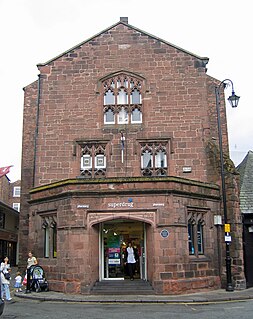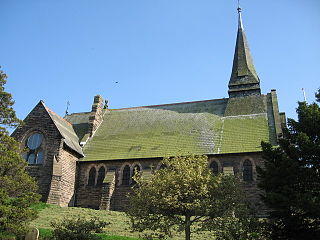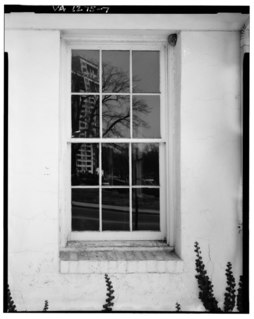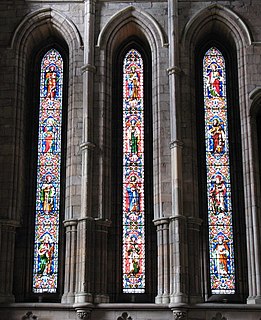
Chester Castle is in the city of Chester, Cheshire, England. It is sited at the southwest extremity of the area bounded by the city walls. The castle stands on an eminence overlooking the River Dee. In the castle complex are the remaining parts of the medieval castle together with the neoclassical buildings designed by Thomas Harrison which were built between 1788 and 1813. Parts of the neoclassical buildings are used today as Crown Courts and as a military museum. The museum and the medieval remains are a tourist attraction.

Capernwray Hall is a former country house situated 3 miles east-northeast of Carnforth, Lancashire, England, and is currently used as a Christian Bible school and holiday centre. The house is recorded in the National Heritage List for England as a designated Grade II* listed building. It stands in grounds included in the Register of Historic Parks and Gardens at Grade II.

Thomas Harrison was an English architect and bridge engineer who trained in Rome, where he studied classical architecture. Returning to England, he won the competition in 1782 for the design of Skerton Bridge in Lancaster. After moving to Lancaster he worked on local buildings, received commissions for further bridges, and designed country houses in Scotland. In 1786 Harrison was asked to design new buildings within the grounds of Lancaster and Chester castles, projects that occupied him, together with other works, until 1815. On both sites he created accommodation for prisoners, law courts, and a shire hall, while working on various other public buildings, gentlemen's clubs, churches, houses, and monuments elsewhere. His final major commission was for the design of Grosvenor Bridge in Chester.

St Mary's Creative Space, formerly the Church of St Mary-on-the-Hill, stands at the top of St Mary's Hill, Chester, Cheshire, England, near Chester Castle. It is recorded in the National Heritage List for England as a designated Grade I listed building. The church stands at the top of a narrow winding lane which leads down to the River Dee, and it is adjacent to Chester Castle. In the 1970s the church was converted into an educational centre. It is currently available for use as a concert and exhibition venue and the Chester Music Society hold many concerts there throughout the year. The building is programmed by Theatre in the Quarter, and the venue hosts a lively programme of art and cultural events, from homegrown Cestrian performers, national and international acts.

St Oswald's Church is in the village of Backford, to the northwest of Chester, Cheshire, England, close to the A41 road and adjoining Backford Hall. It is recorded in the National Heritage List for England as a designated Grade II* listed building. The church dates from the 14th century with later additions and restorations. It contains one of the few surviving aumbries in Cheshire and a number of memorial boards painted by the Randle Holme family. It is an active Anglican parish church in the diocese of Chester, the archdeaconry of Chester and the deanery of Wirral South. Its benefice is combined with that of Holy Trinity Church, Capenhurst. From March 2018 this benefice shares a Vicar with All Saints, Saughall.

St Nicholas' Chapel is a former chapel in St Werburgh Street, Chester, Cheshire, England. Since it ceased functioning as a chapel it has had a number of uses, including being at one time a theatre. It is now used as a shop. It is recorded in the National Heritage List for England as a designated Grade II listed building, and is a scheduled monument.

St Michael and All Angels Church is in the village of Little Leigh, Cheshire, England. The church is recorded in the National Heritage List for England as a designated Grade II listed building. It is an active Anglican parish church in the diocese of Chester, the archdeaconry of Chester and the deanery of Great Budworth. It is one of three parish churches in the parish of Aston-by-Sutton, Little Leigh and Lower Whitley. The others being St Peter, Aston-by-Sutton and St Luke, Lower Whitley. Until 31 May 2013, the three were separate parishes united in a benefice along with St Mark, Antrobus

St Mary's Church is in Overleigh Road in Handbridge, an area south of the River Dee, in the city of Chester, Cheshire, England. It is also known as the Church of St Mary-without-the-Walls. The church is recorded in the National Heritage List for England as a designated Grade II* listed building. It is an active Anglican parish church in the diocese of Chester, the archdeaconry of Chester and the deanery of Chester.

St Paul's Church is in the village of Helsby, Cheshire, England. The church is recorded in the National Heritage List for England as a designated Grade II listed building, and is an active Anglican parish church in the diocese of Chester, the archdeaconry of Chester and the deanery of Frodsham. Its benefice is combined with that of St Luke, Dunham-on-the-Hill.

Christ Church is a Church of England parish church in Somerset Street, Chester, Cheshire, England. It is in the Archdeaconry of Chester and the Deanery of Chester. Its benefice is combined with that of St Michael, Plas Newton. It is a Grade II listed building.

Walmoor Hill is a large house in an elevated position overlooking the River Dee on the west side of Dee Banks, Chester, Cheshire, England. It is recorded in the National Heritage List for England as a designated Grade II* listed building. The authors of the Buildings of England series describe it as a "house of considerable size and panache".

Jodrell Hall is a country house near Jodrell Bank in the parish of Twemlow, in the county of Cheshire, England.

St John's Church is located in the village of High Legh, Cheshire, England, and is an active Anglican parish church in the deanery of Knutsford, the archdeaconry of Macclesfield, and the diocese of Chester.

Whatcroft Hall is a country house situated 1.5 miles (2.4 km) to the southeast of the village of Davenham, Cheshire, England. It stands to the east of, and overlooking, the Trent and Mersey Canal. The house is recorded in the National Heritage List for England as a designated Grade II* listed building.

Willington Hall is a former country house in the parish of Willington, Cheshire, England. It was extended in 1878, but reduced in size in the 1950s, and has since been in use as a hotel.

Christ Church is in the village of Barnton, Cheshire, England. It is an active Anglican parish church in the deanery of Great Budworth, the archdeaconry of Chester, and the diocese of Chester. The church is recorded in the National Heritage List for England as a designated Grade II listed building.

The Blue Coat School is located in Upper Northgate Street, Chester, Cheshire, England. It is recorded in the National Heritage List for England as a designated Grade II* listed building.

St Werburgh's Church is in Grosvenor Park Road, Chester, Cheshire, England. It is an active Roman Catholic parish church in the diocese of Shrewsbury. The church is recorded in the National Heritage List for England as a designated Grade II listed building.

Queen Hotel, Chester, is located on the corner of City Road and Station Road, Chester, Cheshire, England, and stands opposite Chester General Station. The hotel is recorded in the National Heritage List for England as a designated Grade II listed building.

Norcliffe Chapel is in the village of Styal, Cheshire, England. It is a Unitarian chapel, and is recorded in the National Heritage List for England as a designated Grade II listed building. The chapel was built in 1822–23 by a mill owner for his workers, and was extended by his son in 1867. Further additions were made in 1906. The chapel is built in brick, and is in Gothic Revival style. Since 1977 it has been in the ownership of the National Trust, but continues to function as an active Unitarian chapel.



























